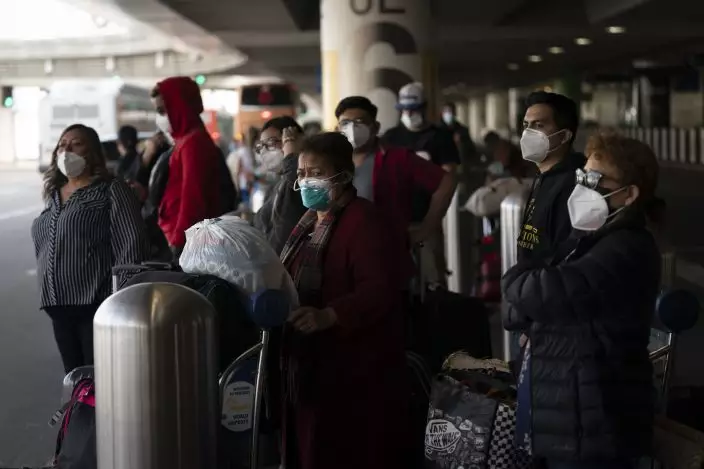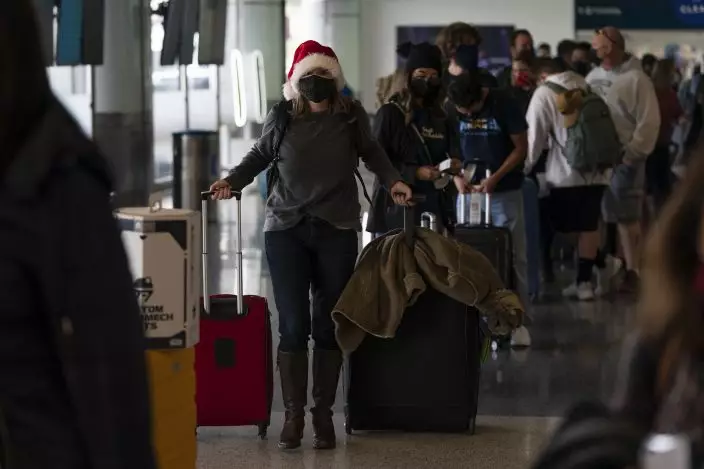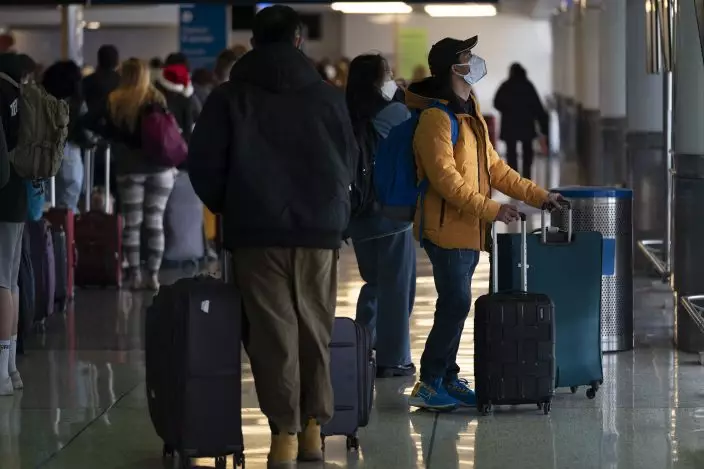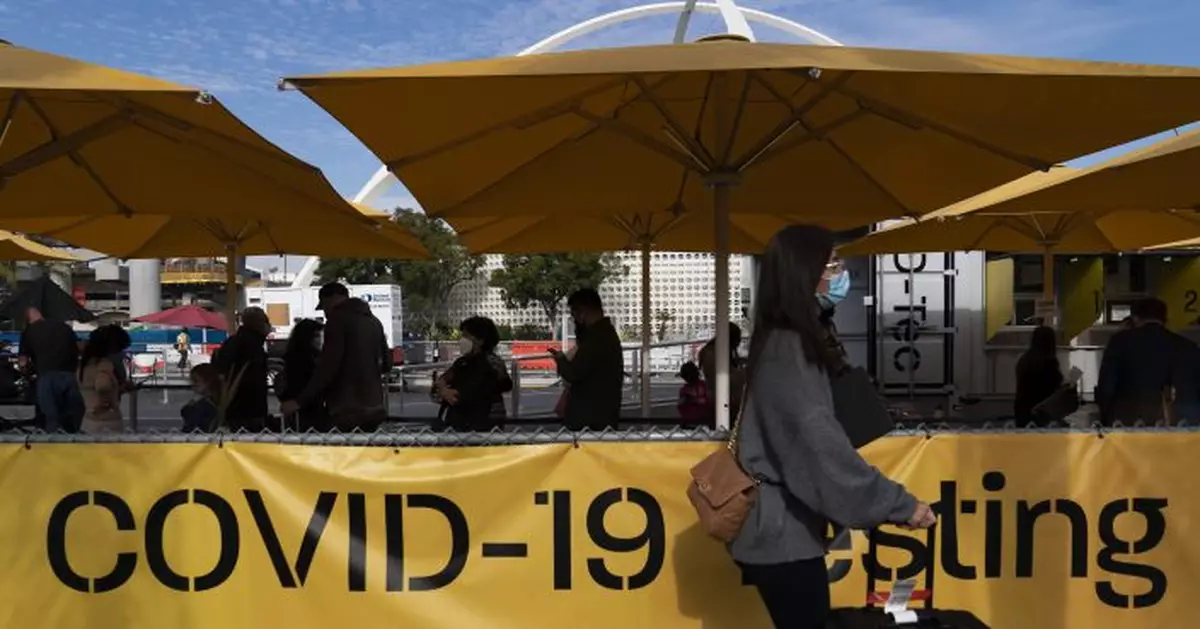Gov. Gavin Newsom on Tuesday said California will require healthcare workers to get booster shots against the coronavirus.
“With Omicron on the rise, we’re taking immediate actions to protect Californians and ensure our hospitals are prepared,” the Democratic governor said in a news release.
California follows New Mexico in the new mandate, his office said.

Travelers wait in line to get tested for COVID-19 at Los Angeles International Airport in Los Angeles, Monday, Dec. 20, 2021. The Los Angeles County Department of Public Health reported more than 3,500 new cases of COVID-19 on Sunday as the number of daily new cases tripled over the week. (AP PhotoJae C. Hong)
The most populous state already required all healthcare workers to be vaccinated by September, with exemptions for medical reasons or personal beliefs.
His office would not say when the new requirement would take effect or if there would be an option for frequent testing instead, promising more details during an event Wednesday.
THIS IS A BREAKING NEWS UPDATE. AP’s earlier story follows below.

Travelers wait for a shuttle but to arrive at the Los Angeles International Airport in Los Angeles, Monday, Dec. 20, 2021. The Los Angeles County Department of Public Health reported more than 3,500 new cases of COVID-19 on Sunday as the number of daily new cases tripled over the week. (AP PhotoJae C. Hong)
California is poised for a surge in new coronavirus infections as a far more contagious version of the disease spreads among holiday parties and family gatherings forced indoors by a series of winter storms.
But experts say the nation's most populous state is likely to avoid the worst scenario — spikes in hospitalizations and deaths — because most Californians have either been vaccinated or already been infected. That gives the state a higher level or protection against the omicron variant that, while not guaranteeing people won't get sick, means they are less likely to need to go to the hospital.
“It's a highly transmissible respiratory virus and people are going to get it. And they are going to get it every winter,” said Dr. Monica Gandhi, a professor of infectious diseases at the University of California, San Francisco. “We have to go toward measuring our true success with a disease, which is how we're doing with hospitalizations.”

Travelers wait in line to check in for a flight at the Los Angeles International Airport in Los Angeles, Monday, Dec. 20, 2021. The Los Angeles County Department of Public Health reported more than 3,500 new cases of COVID-19 on Sunday as the number of daily new cases tripled over the week. (AP PhotoJae C. Hong)
California has fared far better than many other states so far, with areas in the Midwest and Northeast seeing the biggest surge in cases and hospitalizations amid frigid temperatures that have kept people indoors.
The U.S. Centers for Disease Control and Prevention lists California as a place with “high” transmission of the virus, along with nearly everywhere else in the country. But in the last week California averaged 114 new cases per 100,000 people, less than half of the national rate.
Meanwhile, coronavirus related hospitalizations have been rising slowly in California, up 9% in the last two weeks to 3,523. That’s less than half of what it was during the late summer peak fueled by the delta variant and one-fifth what it was a year ago, before vaccines were widely available.

Donning a Santa Claus hat, Caitlin Banford waits in line to check in for her flight to Washington at Los Angeles International Airport in Los Angeles, Monday, Dec. 20, 2021. The Los Angeles County Department of Public Health reported more than 3,500 new cases of COVID-19 on Sunday as the number of daily new cases tripled over the week. (AP PhotoJae C. Hong)
But while hospitals overall have fewer patients than last winter, many have fewer workers to treat the patients they do have. The staffing shortage comes as businesses in general are having trouble finding workers, including hospitals. A recent study by the University of California-San Francisco estimated the state's nursing shortage could persist until 2026.
“The staffing shortages we are experiencing are worse than ever,” said Kiyomi Burchill, group vice president for policy for the California Hospital Association.
More than 70% of the state's nearly 40 million residents have been fully vaccinated while 42% have gotten a booster shot.

Travelers look at the arrival and departure screens at the Los Angeles International Airport in Los Angeles, Monday, Dec. 20, 2021. The Los Angeles County Department of Public Health reported more than 3,500 new cases of COVID-19 on Sunday as the number of daily new cases tripled over the week. (AP PhotoJae C. Hong)
But as of Monday a new variant, omicron, is now the dominant version of the coronavirus in the United States.
Much about the omicron coronavirus variant remains unknown, including whether it causes more or less severe illness. Scientists say omicron spreads even easier than other coronavirus strains, including delta. Early studies suggest the vaccinated will need a booster shot for the best chance at preventing an omicron infection but even without the extra dose, vaccination still should offer strong protection against severe illness and death.
Computer models used by state officials to forecast the virus say hospitalizations will stay steady through the holidays and dip slightly in mid-January.
“I'm on the fence a little bit about how horrible is this,” said Dr. Brad Pollock, associate dean for public health sciences at the University of California, Davis School of Medicine. “We’re going to have more people infected because of the more transmissible variant. It may be a little less virulent, which means it causes less symptoms.”
Indeed, on Monday, the state reported about 26,000 new cases, the largest single-day tally in nearly a year. In San Diego, researchers recently discovered the highest levels of coronavirus since February in a wastewater treatment plant that serves about 2.3 million people.
“Every time we've seen that kind of increase in the wastewater, a couple of weeks later we see an increase in cases,” said Rob Knight, a professor at the University of California-San Diego School of Medicine.
Last week, Gov. Gavin Newsom, who imposed the fist statewide shutdown order in March 2020, warned that cases would likely rise and re-imposed a rule requiring everyone to wear masks at public indoor gatherings. Los Angeles, the nation's second-largest city, once again canceled its in-person New Year's Eve celebration, moving to a virtual event as the number of daily new cases tripled over the week.
Mayor Eric Garcetti said Tuesday that he didn't anticipate another lockdown because “I think we're so much better protected than we were."
However, Garcetti said he believed restrictions such as masking indoors will continue into February and perhaps even March, depending on vaccination, hospitalization and infection rates.
While 70% of Californians have been fully vaccinated, that still leaves 30% — or roughly 12 million people — who haven't. The California Department of Public Health says people who are not vaccinated are seven times more likely to get infected, nearly 13 times more likely to be hospitalized and nearly 16 times more likely to die from the coronavirus.
Places in California with lower vaccination rates, including Riverside and San Bernardino counties, have seen jumps in hospitalizations recently.
“The problem is there are counties in California, particularly in central California and eastern California, where they have had neither high vaccination coverage or a lot of prior infections,” said Dr. Jeffrey Klausner, a professor of infectious diseases at the University of Southern California's Keck School of Medicine. “We can expect in those communities that there may be an increase in hospitalizations for people at high risk for severe consequences.”


